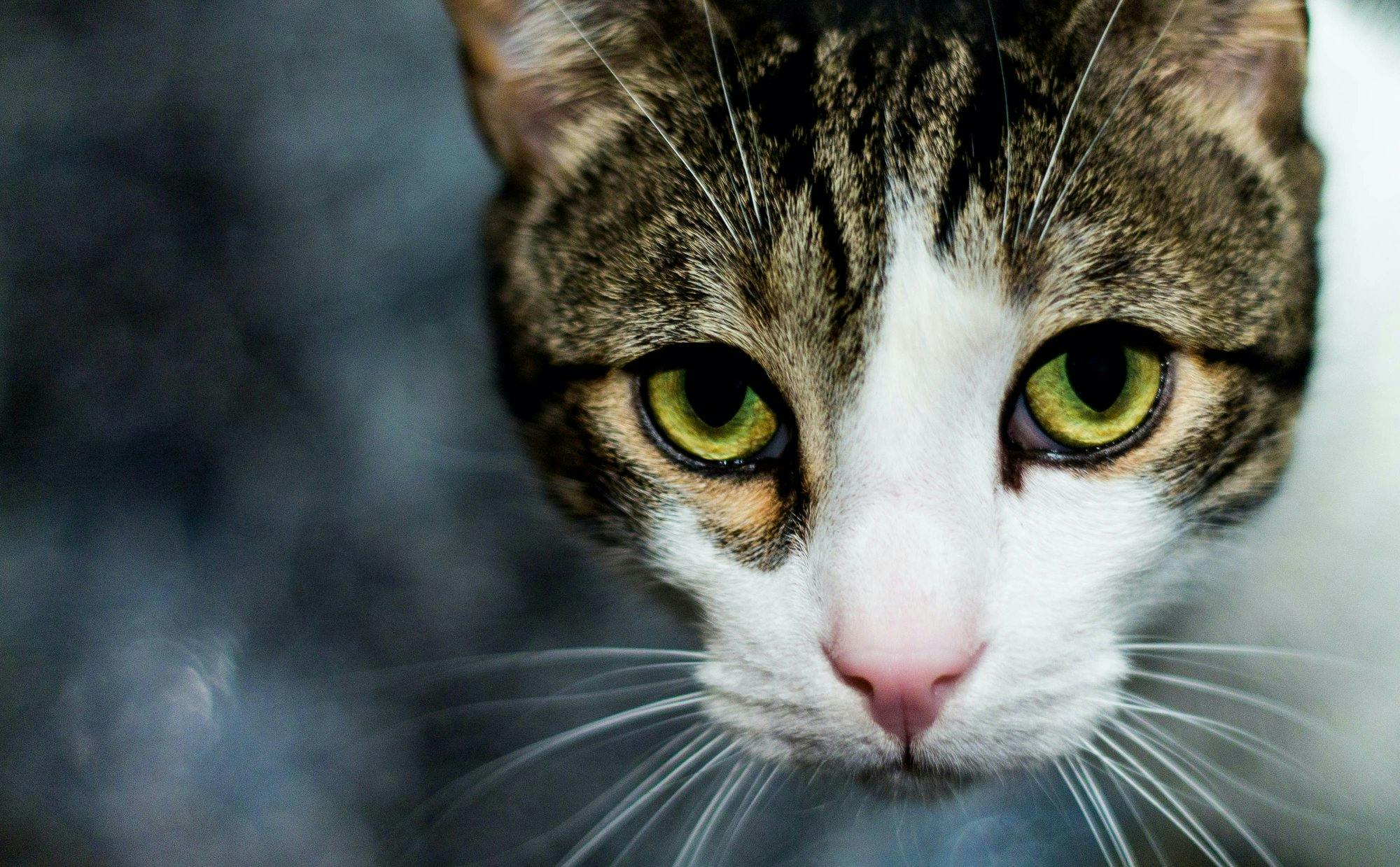
Key Differences Between Pet And Human Senses
Training and Behaviour
General Advice
01/05/2023
Ever wondered why your dog insists on sniffing the lamp post for five minutes? Or why your cat loves meat but not fruit? Although animals and humans all share the same five senses – sight, touch, hearing, smell and taste – in many ways our pets perceive the world differently from us.
Eye spy
Cats and dogs are born blind, with their eyes opening in the first few weeks of life. Felines develop better vision than canines, but both animals are excellent at detecting movement due to their predatory instincts. However, the trade-off is that to them stationary objects appear slightly blurred. They also see fewer colours than people. Goldfish, however, can see a much wider spectrum than us, and are believed to be the only animals that can see both infrared and ultraviolet light.
Animals with eyes that are widely spaced tend to have better peripheral vision than humans. The visual field of sight hounds, for example, is up to double that of a person. Animals that are prey in the wild such as rabbits and guinea pigs tend to have all-round vision with only a small blind-spot in front of their noses so that they can see predators approaching from all angles – that’s why sudden movements may startle them.
Cats, on the other hand, have eyes that are closer together, so they have excellent depth perception – which explains why they can pounce on their toys so accurately! Although they can’t see in total darkness, a feline’s night vision is six times better than a human’s, thanks to light-reflecting screens in their eyes, which make their eyes shine dramatically in the darkness.

Cats develop better vision than dogs
Touchy-feely
Fish have nerve endings all over their skin, but they also have a sensory organ called the lateral line. Running down the sides of their bodies, it helps them sense movement, pressure, objects and even vibrations. Cats and dogs also have touch receptors all over their bodies, so it’s little wonder they love to be petted. As it’s their first sense to develop, they learn to explore new objects by touch – felines use their pressure-sensitive paw-pads, while canines investigate with their mouths.
A cat’s face is concentrated with nerve endings, especially its whiskers. These remarkable hairs, also called vibrissae, are deeply rooted within the skin and are already developed at birth. They help them gauge the position of objects in their environment, so they can decide whether they can squeeze through tight spaces. A cat’s whiskers can also detect changes in air currents, enabling them to locate prey and navigate in the dark. Rabbits, guinea pigs, rats, mice and chinchillas also have long whiskers on their faces, and cats have shorter vibrissae hairs at the back of their front legs, too.
Hear, hear
Many animals have a major advantage over us when it comes to hearing – large, mobile ears. The bigger size magnifies sound waves, while their rotational ability means they can identify noises from many different directions. Animals with floppy ears, such as lop-eared rabbits and spaniel, hound and setter dogs, have less acute hearing than the breeds with erect ears, while white, blue-eyed cats are usually born deaf. Despite these variations, in many cases our pets have more sensitive hearing than us – dogs, for example, can hear sounds up to five times further than we can.
Our four-legged friends also have the ability to hear sounds of a much higher frequency than us. Compared to people who can hear up to 20 kilohertz, dogs can detect sounds up to 35-60khz depending on the breed, cats up to 65khz, and rats and mice up to 90khz. A feline’s ability to identify ultrasonic sounds means it can hear high-pitched rodent squeaks easily, while dogs can hear the Galton training whistle that’s inaudible to the human ear. However, not all animals can hear higher frequencies than us – budgies can only hear up to 9khz, while goldfish can only detect sounds up to 3khz.

Dogs can detect sounds up to 35-60khz
Nose knows
Many pets, especially dogs, have a much more powerful sense of smell than us. Compared to a human’s five million scent-sensitive cells, toy dogs have 125 million, while hunting dogs have as many as 225 million. Canines rely on smell more than any other sense, and have a remarkable ability to distinguish between multiple scents. They are frequently used by the police force, search-and-rescue teams and airport staff to sniff out drugs, bombs and people, as they can detect minute traces of odour – for example, even a single drop of blood in a bucket of water!
Despite their shorter snouts, cats also have a highly developed sense of smell, and use scent-marking as an important means of communication. Felines, especially those that are un-neutered, often spray on fences and trees to mark their territory and communicate their status to other animals. They also have scent glands on their foreheads and the sides of their face, so every time they rub their head on an object or person they’re leaving a scent.
Dogs also scent-mark, and their anal glands produce a strong odour, which they leave as a chemical calling card. Each individual produces a unique scent that contains a wealth of information about its status, sex and stress levels. That’s why dogs sniff under each other’s tails in greeting.
One of the reasons why some animals can smell so well is because they have wet noses. Rabbits wiggle their noses up and down, which activates mucous production to moisten them. The surface of cats’ and dogs’ noses are also damp to dissolve odours so they can be processed by the sensory cells, however, they don’t just smell with their noses – these animals can also detect particular odours through a receptor in the roof of their mouth called the Jacobson’s organ. If felines encounter a scent that they want drawn into this organ, they curl their lips back into a grimace, which is known as the ‘flehmen response’ or ‘flehming.’
Sugar and spice
Because of its location in the mouth with a connection to the nasal passage, the Jacobson’s organ is thought to allow animals to smell and taste simultaneously. However, aside from the combination of smelling and tasting through this organ, animals usually taste their food through tastebuds in their mouths in much the same way that we do. As omnivores, dogs can taste a range of flavours, while cats have a more limited palate. Felines are carnivores so their tastebuds are more attuned to meat than carbohydrates, and they have little, if any, ability to taste sweet food.
But how do our pets stack up against us when it comes to how strongly they can taste their dinner? With 17,000 tastebuds, rabbits have nearly twice as many as people, who have 9000. At the lower end of the scale, dogs have less than 2000 tastebuds, which explains why they wolf down their food without savouring the flavour. More surprising is the fact that cats have a mere 473 tastebuds! Which begs the question: if Fluffy has so few tastebuds, why is she so finicky about her food? But that’s another story…

Guinea Pigs eating
The sixth sense
Animals are renowned for their extraordinary abilities to predict earthquakes, perceive sickness and find their way home over long distances. But are these abilities really due to a ‘sixth sense,’ psychic powers, intuition, or simply that their five senses are more highly developed than ours? Evidence suggests that enhanced senses account for these behaviours in most cases. It’s thought that cats can detect earthquakes by feeling tiny vibrations of low-frequency sound through their paw-pads. Echolocation, used by animals such as bats, dolphins and whales to navigate and find prey, is an advanced form of hearing that involves emitting ultrasonic sound waves and analysing the way they reflect off objects. A heightened sense of smell may also account for a dog’s ability to sense illness, as a 2006 study found that they could smell the difference between breath samples of cancer patients and healthy people. However, there are several instances in which animals display sensitivities that people don’t – sharks, for example, are able to detect electrical signals in their environment, while butterflies and bees have internal compasses that detect magnetic direction. As for animals’ reputed psychic powers – the jury’s still out on that one!